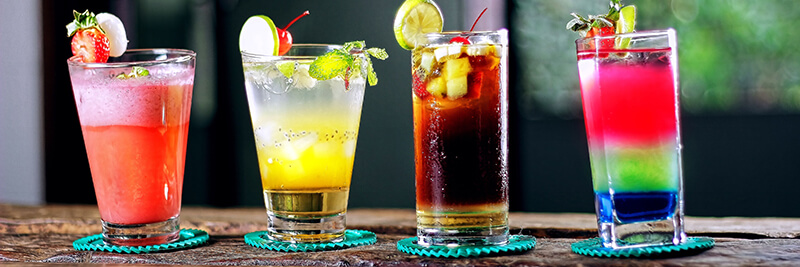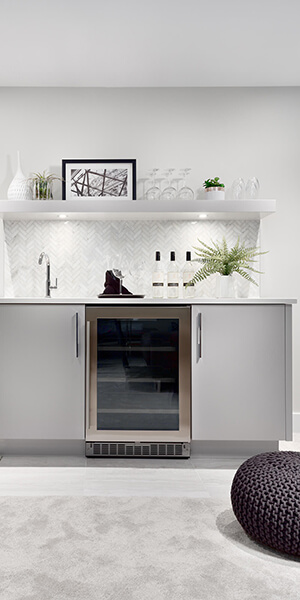Wet bars are beautiful, utilitarian, popular at get-togethers and when just lounging around at home, and can lend just the accent piece your entertaining area is missing. But, how did the wet bar rise to such popularity in the first place?
The Wet Bar’s Beginnings

The wet bar is actually a second-generation feature that owes its roots to the popularity of bar carts in the Victorian Era. The recent resurgence comes from a combination of its utility, the cocktail renaissance that bloomed in the early 2000s, and other influences of previous eras on our modern cocktail culture.
In the Victorian Era bar carts were actually tea trolleys! By the end of prohibition in 1933 tea carts made the transition from Tea Time to Party Time when they began being used for cocktail parties. While bar carts did become associated with cocktail items after the repeal of prohibition, they didn’t come into their own as serious cocktail entertaining centers until the 1950s. There was a transition period where the bar carts of the 30s slowly blended function with style and became integrated into fine pieces of furniture, giving birth to the classic bar cabinets of the 1930s to the 1950s.
Time To Celebrate!
After living through The Great Depression, World War II and The Korean War, rations, poverty, and instability, Americans began to see more prosperity and a rise in the style and entertaining possibilities that followed. And, entertain, they did! People everywhere began hosting and attending parties, and savvy homemakers loved to impress and entertain their family and friends from a fully stocked cart or dry bar for creating alcoholic refreshments for their guests. American Pop Culture and Hollywood lent to the romanticism and intrigue, and to this day, a well-stocked bar will bring back nostalgia for the classic Hollywood Films of the 1950s and the smoke-filled intimate bars Hugh Hefner popularized during the 1960s.
When the 1970s rolled around, homebuilders began building permanent, wet and dry bars with expansive built-in bars and custom cabinetry into their home designs in order to provide interior spaces that were more interactive and functional for people. These typically featured dark wood and leather, lacked personal style, and didn’t offer much in the way of design. As their homes now came standard with a built-in wet or dry bar, the bar cart and bar cabinets fell out of favor (not surprisingly, they’re making a comeback, too!) We’ve come a lot of way since then in the design of built-in bars, both in personal style, use of materials, features, and functionality. It’s not so much that they’re making a comeback as that they’ve gotten a much-needed makeover.
Who Do Wet Bars Appeal To?
Who doesn’t find the idea of a fully-stocked bar with everything from sodas, spritzers, wine, beer, and cocktail mixes and liquors to make any fancy of simple cocktail appealing? From Baby Boomers to Millennials, homeowners today are showcasing their style, personality, and entertaining aesthetic with beautiful custom designed well-stocked bars. With their new versatility, they provide refreshing drinks for everyone from those who enjoy adult libations to young children.

The Difference Between Wet Bars and Dry Bars
You may be wondering what is the difference between a wet bar is a dry bar. While both are designed as built-in cabinetry to enhance your home design and make entertaining at home easy by providing a place to prepare beverages for family and friends, the main difference is that wet bars feature a sink so that glasses can be easily rinsed. While that may seem like a simple difference, it is something to consider when designing your own bar. It doesn’t just involve having to install plumbing, it has to do with what your needs are.
- Do you entertain enough that you don’t want to be lugging glassware to the kitchen every time you entertain?
- Do you anticipate needing to clean up a lot of spills?
That may not seem like much of a problem until you realize you’ll be needing to run to the kitchen sink to keep your bar spill-free. Wet bars have become more popular if you entertain in an area away from your kitchen, such as a home theatre or basement retreat. Nobody wants to run upstairs to make another batch of frozen margaritas or to wash out the pitcher for a different cocktail request. When you have a sink in your wet bar you can keep all of your glasses, pitchers, and cocktail mixing items clean as you use them and you’ll be better equipped to mop up spills and keep your bar clean.
Wet Bars Move Outside
Now, as indoor-outdoor living and entertaining have become more popular, wet bars and kitchens with all your needed amenities are moving alfresco as well. You can turn your backyard into a welcoming resort for hosting family and friends with a little creativity because the new design styles and features never seem to end. If you’re a beer lover you could install taps in your wet bar that include gutters underneath to direct and capture drips, and, if you love wine, you can include a special wine fridge. Have kids to entertain? There’s a mini-fridge for that!
That said, your wet bar doesn’t need to be big or elaborate unless it will be used often in a big-budget home addition like an entertainment room or man cave. You can fit one into your pantry, into your living room, or into any tiny nook you have available. For design ideas about how the perfect wet bar can enhance your lifestyle, entertaining, and interior aesthetic, give Kitchen Art Design a call today.